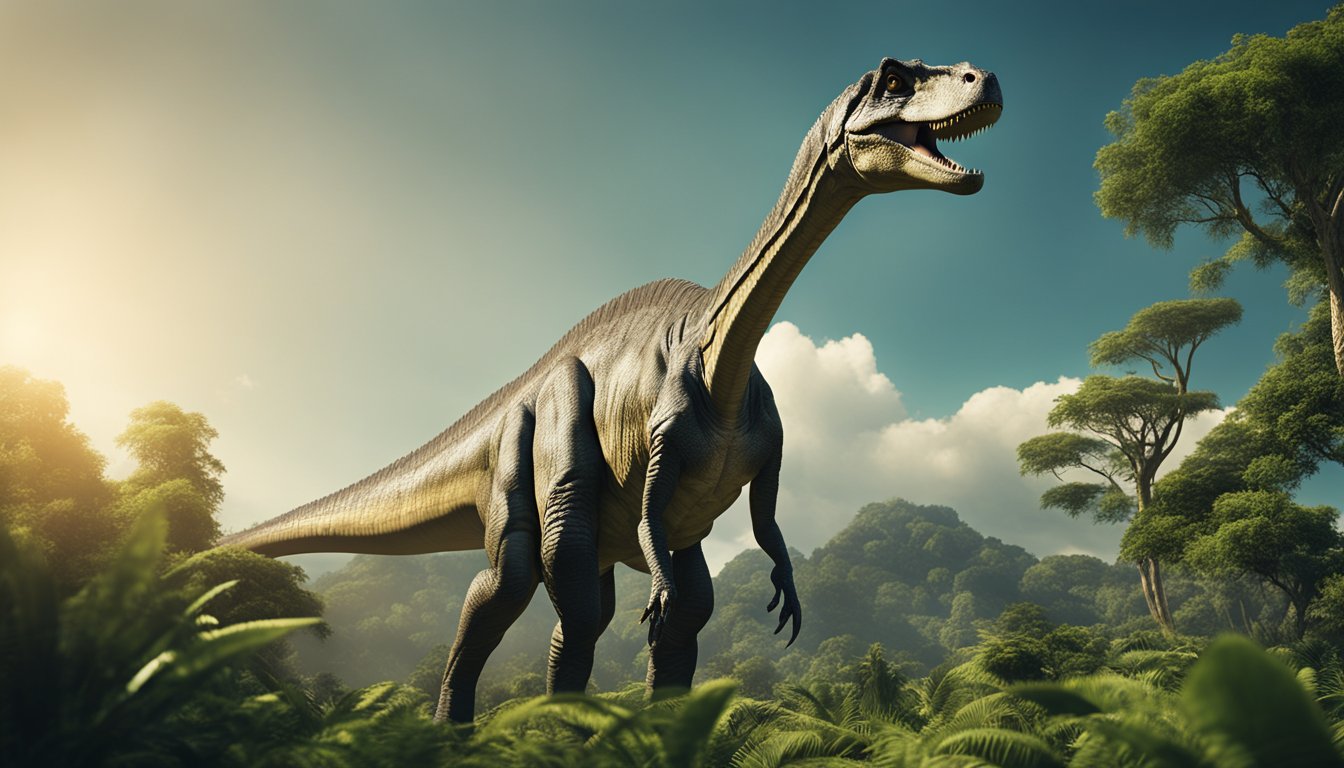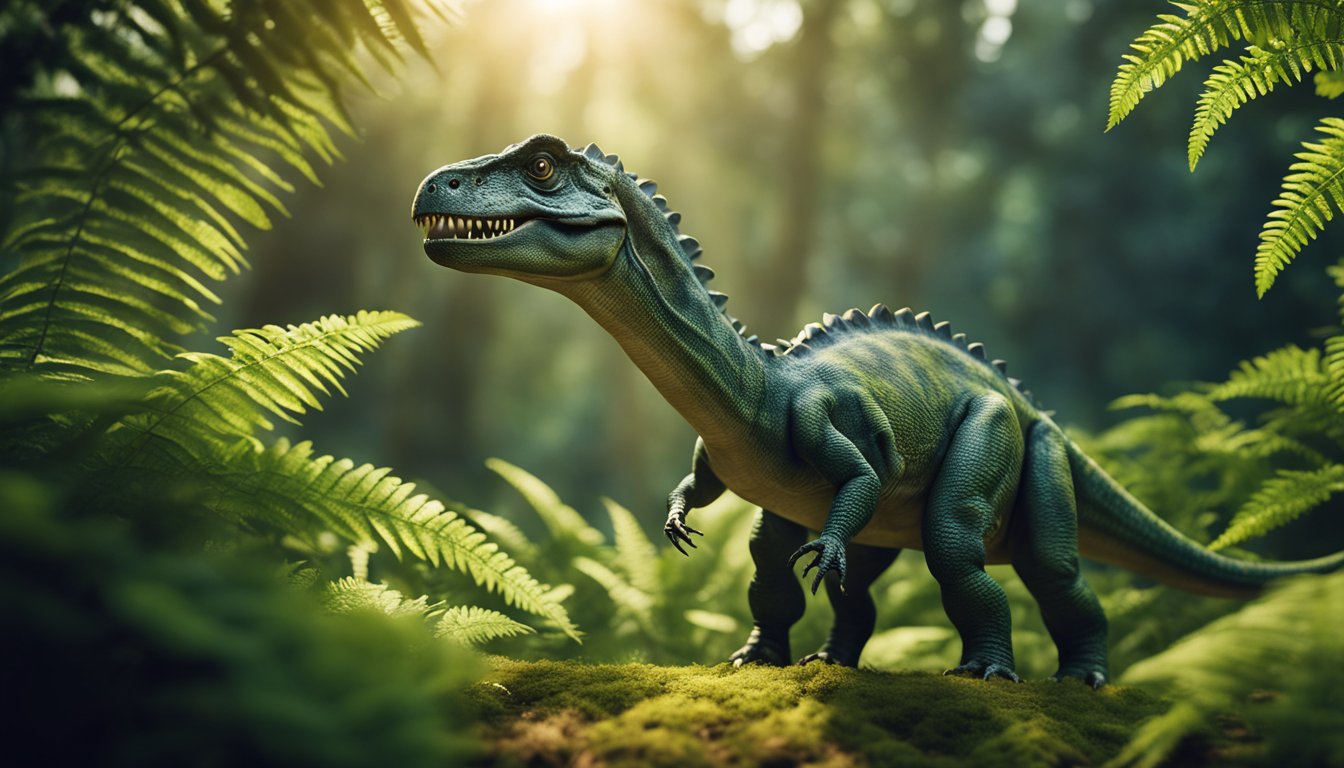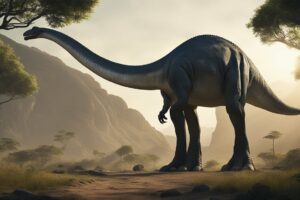Attenborosaurus is a long-necked dinosaur that was named after the legendary broadcaster Sir David Attenborough.
This extinct marine reptile is a member of the Plesiosaur family and is particularly special because it is one of many animal and plant species named after Attenborough.
The dinosaur was first described in 1993, and its fossilized bones were originally identified as a type of Plesiosaurus.

Attenborosaurus combines a long neck with a relatively large head, making it an unusual plesiosaur.
The species name, conybeari, is derived from the original Plesiosaurus conybeari, which was named after William Conybeare, one of two people who named the Plesiosaurus genus back in 1821.
Despite the destruction of Attenborosaurus’ fossilized bones during World War II, scientists have been able to learn a great deal about this fascinating creature through other means, such as studying its relatives and examining fossils from the same time period.
Unveiling the Attenborosaurus
Discovery and Naming
The Attenborosaurus is a prehistoric marine reptile that lived during the Jurassic period.
It was first discovered in southern England in the late 19th century, and was named after Sir David Attenborough, a renowned naturalist and broadcaster.
The type species is Attenborosaurus conybeari, which was originally described by Sollas in 1881.
Bob Bakker coined the new genus name to honor the esteemed wildlife presenter.
Physical Characteristics
The Attenborosaurus had a long neck and a relatively large head, making it an unusual plesiosaur.
Its skeleton is on display at the Natural History Museum in London, where visitors can marvel at its impressive size and unique features.
The Attenborosaurus superficially resembled a plesiosaur, with its long neck and relatively small head.
Its fossils are some of the most well-preserved specimens of marine reptiles ever found.
Habitat and Lifestyle
The Attenborosaurus was an aquatic creature that lived in the oceans during the Jurassic period.
It was a predator that fed on fish and other small marine animals.
The ecosystem of the Jurassic period was vastly different from the present-day, with a diverse array of marine life that included ichthyosaurs, ammonites, and other prehistoric creatures.
Fun Fact: Did you know that the Attenborosaurus is not the only prehistoric animal with an Attenborough-inspired name?
Materpiscis attenboroughi, meaning “mother fish”, got its name after scientists unearthed a fossil of a fish that was pregnant with embryos.
The Attenborosaurus is a fascinating creature that offers a glimpse into the prehistoric world of the Jurassic period.
Its long neck, impressive size, and unique features make it an exciting subject of study for scientists and a popular attraction for museum-goers.
Comparing Giants of the Past

Sauropods and Plesiosaurs
Attenborosaurus was a type of plesiosaur, which is a group of marine reptiles that lived during the Mesozoic Era, around 200 million years ago.
These creatures had long necks and small heads, and were able to swim gracefully through the water.
They were not dinosaurs, but they were closely related to them.
Sauropods, on the other hand, were land-dwelling dinosaurs that lived during the same time period as plesiosaurs.
They were known for their long necks and tails, and their massive size.
Some of the most famous sauropods include Apatosaurus, Brachiosaurus, and Diplodocus.
Evolutionary Relatives
Despite their differences, sauropods and plesiosaurs were both part of a larger group of reptiles known as Archosauria.
This group also included crocodiles, birds, and other types of dinosaurs.
Within the Archosauria group, sauropods and plesiosaurs were both part of distinct subgroups.
Sauropods were part of the Sauropodomorpha group, which also included other long-necked dinosaurs.
Plesiosaurs, on the other hand, were part of the Plesiosauria group, which also included other types of marine reptiles.
Overall, while sauropods and plesiosaurs may have looked very different from one another, they were both fascinating creatures that roamed the Earth during the same time period.
By comparing and contrasting these giants of the past, we can gain a better understanding of the diversity of life that existed millions of years ago.
Life in the Mesozoic Era

The Mesozoic Era, also known as the Age of Dinosaurs, spanned from 252 to 66 million years ago.
During this time, the Earth was a very different place, with a much warmer climate than today.
The Mesozoic Era is divided into three periods: the Triassic, Jurassic, and Cretaceous.
Diet and Behavior
Attenborosaurus, a long-necked marine reptile named after Sir David Attenborough, lived during the Cretaceous Period.
This herbivorous creature likely fed on vegetation found in the oceans, such as seaweed and kelp.
Its long neck and streamlined body allowed it to move quickly through the water, avoiding predators.
Extinction Events
The Mesozoic Era was marked by several extinction events, including the famous one that wiped out the dinosaurs.
The cause of this extinction is still debated, but most scientists believe it was triggered by a massive asteroid impact that caused a global cataclysm.
This event led to the extinction of many species, including Attenborosaurus.
Despite the extinction events, the Mesozoic Era was a time of great biodiversity, with many different species of herbivores, predators, and vegetation.
It was a time when the Earth was ruled by giant reptiles and when the oceans were home to strange and fascinating creatures like Attenborosaurus.
Fun fact: Did you know that the asteroid that caused the extinction of the dinosaurs was estimated to be about 6 miles wide and traveling at a speed of 40,000 miles per hour?
That’s faster than a commercial jet!
Frequently Asked Questions

How much did the Attenborosaurus weigh?
The weight of Attenborosaurus remains unknown as scientists have not found a complete skeleton of this long-necked dinosaur.
However, based on the size of its skull and other bones, researchers estimate that it may have weighed between 1 and 10 tons.
Can I see an Attenborosaurus at the Natural History Museum?
Yes, you can! The Natural History Museum in London has a life-size model of Attenborosaurus on display.
The model is based on the fossil remains of this prehistoric creature and is a great way to learn more about this fascinating dinosaur.
Which prehistoric creature is named in honor of Sir David Attenborough?
Attenborosaurus is the prehistoric creature named in honor of Sir David Attenborough.
This long-necked marine reptile lived during the Early Jurassic period, around 180 million years ago.
Sir David Attenborough is a well-known naturalist and broadcaster who has dedicated his life to educating people about the wonders of the natural world.
What era did the Attenborosaurus live in?
The Attenborosaurus lived during the Early Jurassic period, around 180 million years ago.
This was a time when dinosaurs and other prehistoric creatures roamed the Earth.
During this era, the continents were still connected in a single landmass called Pangaea.
What did the Attenborosaurus typically eat?
As a marine reptile, the Attenborosaurus likely fed on fish, squid, and other small marine creatures.
Its long neck and powerful jaws would have made it well-suited for catching and eating these types of prey.
How does the Attenborosaurus compare to modern-day animals?
The Attenborosaurus is similar in some ways to modern-day marine animals, such as whales and dolphins.
Like these creatures, the Attenborosaurus was adapted to life in the water, with streamlined bodies and powerful tails for swimming.
However, the Attenborosaurus also had a long neck and a large head, which set it apart from most modern-day marine animals.






